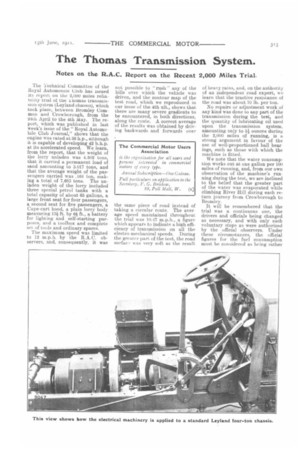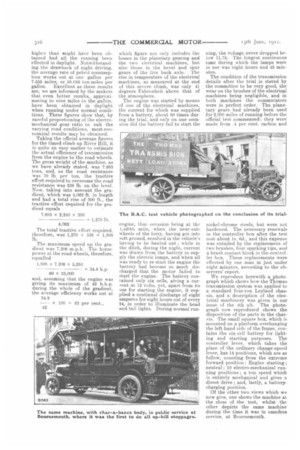The Thomas Transmission System.
Page 15

Page 16

If you've noticed an error in this article please click here to report it so we can fix it.
Notes on the R.A.C. Report on the Recent 2,000 Miles Trial.
not possible to " rush " any of the hills over which the vehicle was driven, and the contour map of the test road, which we reproduced in our issue of the 4th ult., shows that there are many severe gradients to be encountered, in both directions, along the route. A correct average of the results was obtained by driving backwards and forwards over
The Technical Committee of the Royal Automobile Club has issued its report on tae 2,UUU miles reliability trial ot the Thomas transmission system (Leyland chassis), which took place, between Bromley Common and Crowborough, from the 24th April to the 4th may. The report, which was published in last week's issue of the " Royal Automobile Club Journal," shows that the engine was rated at 36 h.p., although it is capable of developing 42 b.h.p. at its accelerated speed. We learn, from the report, that the weight of the lorry unladen was 4.502 tons, that it carried a permanent load of sand amounting to 3.017 tons, and that the average weight of the passengers carried was .164 ton, making a total of 7.683 tons. The unladen weight of the lorry included three special petrol tanks with a total capacity of about 65 gallons, a large front seat for four passengers, a second seat for five passengers, a Cape-cart hood, a plain lorry body measuring 134 ft. by 64 ft., a battery for lighting and self-starting purposes, and a toolbox and complete set of tools and ordinary spares.
The maximum speed was limited to 12 m.p.h. by the R.A.C. observers, and, consequently, it was the same piece of road instead of taking a circular route. The average speed maintained throughout the trial was 10.47 m.p.h., a figure which appears to indicate a high efficiency of transmission on all the electro-mechanical speeds. During the greater part of the test, the road surfae:. was very soft as the result of heavy rains, and, on the authority of an independent road expert, we learn that the tractive resistance of the road was about 70 lb. per ton.
No repairs or adjustment work of any kind was done to any part of the transmission during the test, and the quantity of lubricating oil used upon the transmission system, amounting only to 51 ounces during the 2,000 miles of running, is a strong argument in favour of the use of well-proportioned ball bear ings, such as those with which the machine is fitted.
We note that the water consumption works out at one gallon per 100 miles of running, and, from our own observation of the machine's running during the test, we are inclined to the belief that the greater part of the water was evaporated while climbing River Hill during each return journey from Crowborough to Bromley.
It will be remembered that the trial was a continuous one, the drivers and officials being changed as necessary, and with only such voluntary stops as were authorized by the official observers. Under these circumstances, the official figures for the fuel consumption must be considered as being rather
higher than might have been obtained had all the running been effected in daylight. Notwithstanding the drawback of night driving, the average rate of petrol consumption works out at one gallon per 7.555 miles, or 58.046 ton-miles per gallon. Excellent as these results are, we are informed by the makers that even better results, approximating to nine miles to the gallon, have been obtained in daylight when running under normal conditions. These figures show that, by careful proportioning of the electromechanical gear ratio to suit the varying road conditions, most-economical results may be obtained.
Taking the official average figures for the timed climb up River Hill, it is quite an easy matter to estimate the actual efficiency of transmission from the engine to the road wheels. The gross weight of the machine, as we have already stated, was 7.683 tons, and, as the road resistance was 70 lb. per ton, the tractive effort required to overcome the road resistance was 538 lb. on the level. Now, taking into account the gradient, which was 4,062 ft. in length and had a total rise of 300 ft., the tractive effort required for the gradient equals
7.683 x 2,240 X 300
— 1,270 lb. 4,062 The total tractive effort required. therefore, was 1,270 ± 538 = 1,808 lb.
The maximum speed up the gradient was 7.'206 m.p.h. The horsepower at the road wheels, therefore. equalled
1,808 x 7.206 x 5,280
= 34.8 h.p. 60 x 33,000
and, assuming that the engine was giving its maximum of 42 b.h.p. during the whole of the gradient, the average efficiency works out at 34.8
x 100 = 83 per cent.,
42 which figure not only includes the losses in the planetary gearing and the two electrical machines, but also those in the bevel and spur gears of the live back axle. The rise in temperature of the electrical machines, as measured at the end of this severe climb, was only 41 degrees Fahrenheit above that of the atmosphere.
The engine was started by means of one of the electrical machines, the current for which was supplied from a battery, about 80 times during the trial, and only on one occasion did the battery fail to start the
engine, that, occasion being at the 1,420th mile, when the near-side wheels of the lorry, having got. into soft ground, resulted in the vehicle's having to be hauled out ; while in the ditch, during the night, current was drawn from the battery to supply the electric lamps, and when all was ready to re-start the engine the battery had become so much discharged that the motor failed to start the engine. The battery contained only six cells, giving a current at 12 volts, yet, apart from its use for starting the engine, it supplied a continual discharge of eight amperes for eight hours out of every 24, in order to illuminate the head and tail lights. During normal run ning, the voltage never dropped below 11.75. The longest continuous time during which the lamps were in use was eight hours and 45 minutes.
The condition of the transmission details after the trial is stated by the committee to be very good, the wear on the brushes of the electrical machines being negligible, and in both machines the commutators were in perfect order. The planetary gears had already been used for 2,000 miles of running before the official test commenced: they were made from .4 per cent, carbon and
nickel-chrome steels, but were not hardened, The necessary renewals in the controller box after the test cost about is. 6d., and this expense was entailed by the replacement of two brushes, four sparking tips, and a brush contact block in the controller box. These replacements were effected by one man in just under eight minutes, according to the observers' report.
We reproduce herewith a photograph which shows how the Thomas transmission system was applied to a standard four-ton Leyland chassis, and a description of the electrical machinery was given in our issue of the 4th ult. The photograph now reproduced shows the disposition of the parts in the chassis. The small square box, which is mounted on a platform overhanging the left-hand side of the frame, contains the six-cell battery for lighting and starting purposes. The controller lever, which takes the place of the ordinary change-speed lever, has 14 positions, which are as follow, counting from the -extreme forward position: Engine starting ; neutral ; 10 electro-mechanical running positions ; a top speed which is entirely mechanical and gives a direct drive ; and, lastly, a batterycharging position.
Of the other two views which we now give, one shows the machine at the close of the test, whilst the other depicts the same machine during the time it was in omnibus service, at Bournemouth.




















